The Deccan sultanates were five late-medieval Indian kingdoms—on the Deccan Plateau between the Krishna River and the Vindhya Range—that were created from the disintegration of the Bahmani Sultanate and ruled by Muslim dynasties: namely Ahmadnagar, Berar, Bidar, Bijapur, and Golconda. The sultanates had become independent during the break-up of the Bahmani Sultanate. The five sultanates owed their existence to the declaration of independence of Ahmadnagar in 1490, followed by Bijapur and Berar in the same year. Golconda became independent in 1518, and Bidar in 1528.
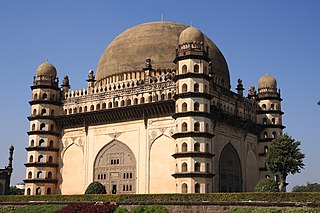
Gol Gumbaz, also written Gol Gumbad, is a 17th-century mausoleum located in Bijapur, a city in Karnataka, India. It houses the remains of Mohammad Adil Shah, seventh sultan of the Adil Shahi dynasty, and some of his relatives. Begun in the mid-17th century, the structure never reached completion. The mausoleum is notable for its scale and exceptionally large dome. The structure is an important example of Adil Shahi architecture.
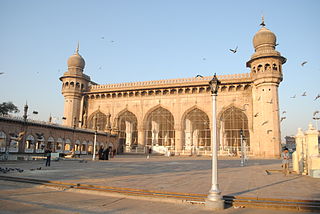
Makkah Masjid or Mecca Masjid, is a congregational mosque in Hyderabad, India. It is the largest mosque in the city, and one of the largest mosques in the country, with a capacity of 10,000 people. The mosque was built during the 17th century, and is a state-protected monument. It serves as the primary mosque for the Old City of Hyderabad, and is located close to the historic landmarks of Charminar, Chowmahalla Palace and Laad Bazaar.

Indo-Islamic architecture is the architecture of the Indian subcontinent produced by and for Islamic patrons and purposes. Despite an initial Arab presence in Sindh, the development of Indo-Islamic architecture began in earnest with the establishment of Delhi as the capital of the Ghurid dynasty in 1193. Succeeding the Ghurids was the Delhi Sultanate, a series of Central Asian dynasties that consolidated much of North, East, and Central India, and later by the Mughal Empire during the early 16th century. Both of these dynasties introduced Islamic architecture and art styles from West Asia into the Indian subcontinent.

The Adina Mosque (N-WB-81) is a former mosque in Malda District, West Bengal, India. It was the largest structure of its kind in the Indian subcontinent and was built during the Bengal Sultanate as a royal mosque by Sikandar Shah, who is also buried inside. The mosque is situated in Pandua, a former royal capital.

The Jama Masjid of Bijapur is a congregational mosque in the Indian state of Karnataka. Initiated by Ali Adil Shah I of the Bijapur Sultanate in the 16th century, the mosque was never completed. It is the largest mosque in Bijapur, and has a capacity of 4000 worshippers.

The Sultanate of Ahmednagar or the Nizam Shahi Sultanate was a late medieval Indian Muslim kingdom located in the northwestern Deccan, between the sultanates of Gujarat and Bijapur, ruled by the Nizam Shahi or Bahri dynasty. It was established when Malik Ahmed, the Bahmani governor of Junnar after defeating the Bahmani army led by general Jahangir Khan on 28 May 1490 declared independence and established the Nizam Shahi dynasty of the Sultanate of Ahmednagar.

Moth ki Mosque is a heritage building located in Delhi, and was built in 1505 by Wazir Miya Bhoiya, Prime Minister during the reign of Sikander Lodi (1489–1517) of the Lodi dynasty. It was a new type of mosque developed by the Lodis in the fourth city of the medieval Delhi of the Delhi Sultanate. The name of the mosque literally translated into English language means ‘Lentil Mosque’ and this name tag ‘Lentil’ has an interesting legend. This mosque was considered a beautiful Dome (Gumbad) structure of the period.

Jahanpanah was the fourth medieval city of Delhi established in 1326–1327 by Muhammad bin Tughlaq (1325–51), of the Delhi Sultanate. To address the constant threat of the Mongols, Tughlaq built the fortified city of Jahanpanah subsuming the Adilabad fort that had been built in the 14th century and also all the establishments lying between Qila Rai Pithora and Siri Fort. Neither the city nor the fort has survived. Many reasons have been offered for such a situation. One of which is stated as the idiosyncratic rule of Mohammed bin Tughlaq when inexplicably he shifted the capital to Daulatabad in the Deccan and came back to Delhi soon after.
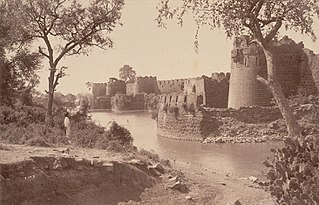
The Gulbarga Fort is located in Kalaburagi in the Kalaburagi district of North Karnataka. This fort was originally constructed by a hindu king Raja Gulchand, it was subsequently significantly enlarged in 1347 by Al-ud-din Hasan Bahmani of the Bahmani Dynasty after he cut off his ties with the Delhi Sultanate; Islamic monuments such as mosques, palaces, tombs, and other structures were also built later within the refurbished fort. The Jama Masjid built later, within the fort, in 1367, is a unique structure built in Persian architectural style, fully enclosed, with elegant domes and arched columns, which is unlike any other mosque in India. It was built to commemorate the establishment of the dynastic rule of the Bahmani kingdom at Kalaburagi fort between 1327 and 1424. It remained the capital of the Bahmani Kingdom till 1424 where after the capital was shifted to Bidar Fort, as Bidar had better climatic conditions.
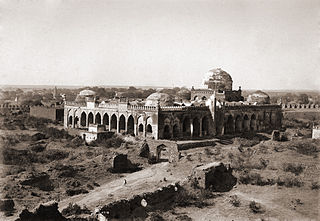
Jamia Masjid Gulbarga or Friday Mosque of Gulbarga is a mosque located in Gulbarga, Karnataka, India.

Toli Masjid, also known as Damri Masjid, is a mosque in Hyderabad, in the Indian state of Telangana. It was constructed during the Qutb Shahi period and completed in 1671.
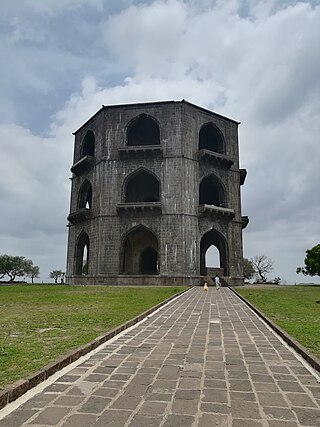
The Tomb of Salabat Khan II is also commonly but mistakenly known as Chandbiwi's Mahel, Chand Bibi Palace or similar variations. It is a three-storey stone structure situated on the crest of a hill, 13 km from Ahmednagar city in the state of Maharashtra, India,
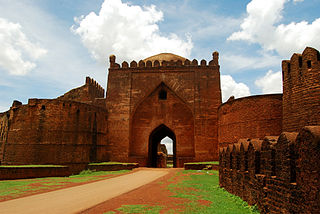
Deccani architecture, particularly the architecture of the Bahmani and Deccan Sultanates, is the architecture of the Deccan Plateau, and is a regional variant of Indo-Islamic architecture. It was influenced by the styles of the Delhi Sultanate and later Mughal architecture, but sometimes also influenced from Persia and Central Asia. Hindu temple architecture in the same areas had very different styles.

Kulsum Begum Masjid is a mosque in the Karwan locality of Hyderabad, India. It was built in the 17th century by Kulsum Begum, daughter of Sultan Muhammad Qutb Shah.
Qutb Shahi architecture is the distinct style of Indo-Islamic architecture developed during the reign of the Qutb Shahi dynasty, also known as the Golconda Sultanate.
The ShahiMosque, also known as the Alamgiri Mosque, is located in Aurangabad, a city in Maharashtra, India. It was built in 1693 by Mughal emperor Aurangzeb for his private use. It is one of the few surviving structures of the Qila-e-Ark, a fortified palace complex built as Aurangzeb's residence in Aurangabad, and is situated in its eastern flank. The structure was referred to as the Alamgiri Mosque as late as the twentieth century, and it is commonly known as the Shahi Mosque in the modern era.

Mecca Masjid is a mosque in Bijapur, in the Indian state of Karnataka. The mosque was built especially for women of the royal household. It is listed as a monument of national importance.

The Tomb of Malik Ambar is a mausoleum located in Khuldabad, in the Indian state of Maharashtra. It is the burial place of Malik Ambar, a military leader who served as the prime minister of the Ahmadnagar Sultanate. Ambar built the tomb for himself, and was interred here upon his death in 1626. It is listed as a monument of national importance.

















